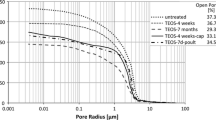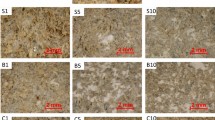Abstract
The efficacy of stone consolidating treatments is significantly affected by the application procedure, including the technique used and the amount of product applied. Indeed, in the common on-site practice, consolidants are not applied until ‘apparent refusal’ (i.e. a drastic slowing down of the liquid absorption by the substrate), as usually recommended in commercial products’ technical data sheets and performed in laboratory tests, but a lower number of applications is performed for practical and economic reasons. Nevertheless, the influence of the application procedure on the absorption mechanism and distribution of the consolidant has not been fully elucidated yet, especially for solvent-based products, for which a competition between capillary uptake and solvent evaporation might arise. In this study, the influence of the treatment conditions on the consolidant efficacy was investigated with the aim of determining whether increasing the number of applications results in a deeper penetration depth and remarkably higher mechanical properties or in a higher saturation of the surface layer. For the experimental tests, an organic solvent-based ethyl silicate (or tetra-ethyl-ortho-silicate, TEOS) was selected, as it is the most commonly-used product in stone consolidation. Brushing was selected as the application method, because it is widely used in current practice and because it involves a discontinuous fluid supply to the stone, possibly causing an over-accumulation of product near the surface. Two different treatments were compared: brushing application by 5 strokes (T1) and 10 strokes (T2). The effect of the two treatments, applied on a porous limestone, was evaluated in terms of increase in mechanical properties (tensile strength, resistance to abrasion), alteration in microstructural features (determined by mercury intrusion porosimetry) and penetration depth (assessed by visual inspection of fractured samples, water sorptivity test and dynamic X-ray radiography). The results of the study indicate that increasing the number of TEOS applications from 5 to 10 brush strokes leads to a higher (but less than proportional) increase in mechanical properties (+33 % for T1, +47 % for T2) and a higher penetration depth (7–8 mm for T1, 12–13 mm for T2), while no accumulation of the additional product near the surface and no hard crust formation were found.





Similar content being viewed by others
References
Scherer GW, Wheeler GS (2009) Silicate consolidants for stone. Key Eng Mater 391:1–25
Tulliani JM, Formia A, Sangermano M (2011) Organic-inorganic material for the consolidation of plaster. J Cult Herit 12:364–371
Ferreira Pinto AP, Delgado Rodriguez J (2008) Stone consolidation: the role of treatment procedures. J Cult Herit 9:38–53
Moropoulou A, Haralampopoulos G, Tsiourva Th, Auger F, Birginie JM (2003) Artificial weathering and non-destructive tests for the performance evaluation of consolidation materials applied on porous stones. Mater Struct 36:210–217
Maravelaki-Kalaitzaki P, Kallithrakas-Kontos N, Korakaki D, Agioutantis Z, Maurigiannakis S (2006) Evaluation of silicon-based strengthening agents on porous limestones. Prog Org Coat 57:140–148
Maravelaki-Kalaitzaki P, Kallithrakas-Kontos N, Agioutantis Z, Maurigiannakis S, Korakaki D (2008) A comparative study of porous limestones treated with silicon-based strengthening agents. Prog Org Coat 62:49–60
Ferreira Pinto AP, Delgado Rodriguez J (2012) Consolidation of carbonate stones: influence of treating procedures on the strengthening action of consolidants. J Cult Herit 13:154–166
Franzoni E, Pigino B, Leeman A, Lura P (2014) Use of TEOS for fired-clay bricks consolidation. Mater Struct 47(7):1175–1184
Amoroso G, Fassina V (1983) Stone decay and conservation. Elsevier, New York
Wheeler G (2005) Alkoxysilanes and the consolidation of stone (Research in conservation). The Getty Conservation Institute, Los Angeles
Franzoni E, Pigino B (2011) The role of moisture in sandstone decay in the monumental cemetery of Bologna (Italy). In: Stefanaggi M, Verges-Belmin V (eds) Proceeding of Jardins de Pierres, conservation of stone in parks, gardens and cemeteries Conference, Paris, XL Print Saint-Etienne, 22–24 June 2011, p 377
Pinna D, Salvadori B, Porcinai S (2011) Evaluation of the application conditions of artificial protection treatments on salt-laden limestones and marble. Constr Build Mater 25:2723–2732
Lazzarini L, Laurenzi Tabasso M (1986) Il restauro della pietra. CEDAM, Padova
Franzoni E, Sassoni E, Graziani G (2014) Brushing, poultice or immersion? the role of the application technique on the performance of a novel hydroxyapatite-based consolidating treatment for limestone. J Cult Herit. doi:10.1016/j.culher.2014.05.009
Franzoni E, Pigino B, Pistolesi C (2013) Ethyl silicate for surface protection of concrete: performance in comparison with other inorganic surface treatments. Cement Concr Compos 44:69–76
Franzoni E, Varum H, Natali ME, Bignozzi MC, Melo J, Rocha L, Pereira E (2014) Improvement of historic reinforced concrete/mortars by impregnation and electrochemical methods. Cement Concr Compos 49:50–58
Croveri P, Dei L, Giorgi R, Salvadori B (2004) Consolidation of globigerina limestone (Malta) by means of inorganic treatment: preliminary results. In: Proceedings of International congress on deterioration and conservation of stone, Stockholm, 2004, pp 463–470
Cassar J (2002) Deterioration of the Globigerina Limestone of the Maltese Islands. Geol Soc Lond Spec Publ 205:33–49
Briffa SM, Sinagra E, Vella D (in press) TEOS based consolidants for Maltese globigerina limestone: effect of hydroxyl conversion treatment. In: Proceedings of 12th international congress on deterioration and conservation of stone, New York City, 22–26 October
Franzoni E, Sassoni E, Scherer GW, Naidu S (2013) Artificial weathering of stone by heating. J Cult Herit 14S:e85–e93
Sassoni E, Franzoni E, Scherer GW, Naidu S (in press) Consolidation of a porous limestone by means of a new treatment based on hydroxyapatite. In: Proceedings of 12th international congress on deterioration and conservation of stone, New York City, 22–26 October 2012
Rothert E, Eggers T, Cassar J, Ruedrich J, Fitzner B, Siegesmund S (2007) Stone properties and weathering induced by salt crystallization of Maltese Globigerina Limestone. In: Přikryl R, Smith BJ (eds) Building stone decay: from diagnosis to conservation. Geological Society, London, pp 189–198
Sassoni E, Franzoni E (2014) Influence of porosity on artificial deterioration of marble and limestone by heating. Appl Phys A-Mater 115(3):809–816
Sassoni E, Franzoni E, Pigino B, Scherer GW, Naidu S (2013) Consolidation of calcareous and siliceous sandstones by hydroxyapatite: comparison with a TEOS-based consolidant. J Cult Herit 14S:e103–e108
Leroux L, Vergès-Belmin V, Costa D, Delgado Rodrigues J, Tiano P, Snethlage R, Singer B, Massey S, De Wi E (2000) Measuring the penetration depth of consolidating products: comparison of six methods. In: Proceedings of the IX international congress on the deterioration and conservation of stone, Venice, 19–24 June 2000, pp 361–370
Conti C, Colombo C, Dellasega D, Matteini M, Realini M, Zerbi G (2011) Ammonium oxalate treatment: evaluation by μ-Raman mapping of the penetration depth in different plasters. J Cult Herit 12:372–379
Sassoni E, Naidu S, Scherer GW (2011) The use of hydroxyapatite as a new inorganic consolidant for damaged carbonate stones. J Cult Herit 12:346–355
Karatasios I, Theoulakis P, Kalagri A, Sapalidis A, Kilikoglou V (2009) Evaluation of consolidation treatments of marly limestones used in archaeological monuments. Constr Build Mater 23:2803–2812
Naidu S, Liu C, Scherer GW (2014) Hydroxyapatite-based consolidant and the acceleration of hydrolysis of silicate-based consolidants. J Cult Herit. doi:10.1016/j.culher.2014.01.001
Sandrolini F, Franzoni E, Cuppini G (2000) Predictive diagnostics for decayed ashlars substitution in architectural restoration in Malta. Mater Eng 11:323–337
Wheeler G (2005) Alkoxysilanes and the consolidation of stone. The Getty Conservation Institute, Los Angeles
European Standard EN 15801, Conservation of cultural property—test methods—determination of water absorption by capillarity, 2010
Borgia GC, Camaiti M, Cerri F, Fantazzini P, Piacenti F (2003) Hydrophobic treatments for stone conservation: influence of the application method on penetration, distribution and efficiency. Stud Conserv 48:217–226
Gombia M, Bortolotti V, Brown JS, Camaiti M, Fantazzini P (2008) Models of water imbibition in untreated and treated porous media validated by quantitative magnetic resonance imaging. J Appl Phys 103:094913
Cnudde V, Cnudde JP, Dupuis C, Jacobs PJS (2004) X-ray micro-CT used for the localization of water repellents and consolidants inside natural building stones. Mater Charact 53:259–271
Cnudde V, Dubruel P, De Winne K, De Witte I, Masschaele B, Jacobs P, Schacht E (2008) The use of X-ray tomography in the study of water repellents and consolidants. Eng Geol 103:84–92
Slavíková M, Krejčí F, Žemlička J, Pech M, Kotlík P, Jakůbek J (2012) X-ray radiography and tomography for monitoring the penetration depth of consolidants in Opuka—the building stone of Prague monuments. J Cult Herit 13:357–364
Cnudde V, Dierick M, Vlassenbroeck J, Masschaele B, Lehmann E, Jacobs P, Van Hoorebek L (2008) High-speed neutron radiography for monitoring the water absorption by capillarity in porous materials. Nucl Instr Methods Phys Res B 266:155–163
Acknowledgments
Paolo Carta (DICAM) is gratefully acknowledged for his support. The dynamic X-ray radiography measurements were made possible thanks to the support of Iwan Jerjen (Center for X-ray Analytics and Laboratory for Reliability Science and Technology, Empa), Roger Vonbank and Stephan Carl (Laboratory for Building Science and Technology, Empa) and Fei Yang (Concrete and Construction Chemistry Laboratory and Center for X-ray Analytics, Empa, and IfB, ETHZ).
Author information
Authors and Affiliations
Corresponding author
Rights and permissions
About this article
Cite this article
Franzoni, E., Graziani, G., Sassoni, E. et al. Solvent-based ethyl silicate for stone consolidation: influence of the application technique on penetration depth, efficacy and pore occlusion. Mater Struct 48, 3503–3515 (2015). https://doi.org/10.1617/s11527-014-0417-1
Received:
Accepted:
Published:
Issue Date:
DOI: https://doi.org/10.1617/s11527-014-0417-1




